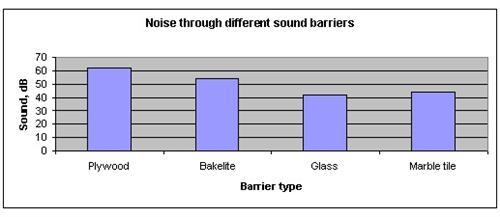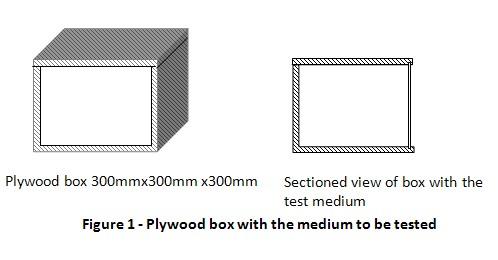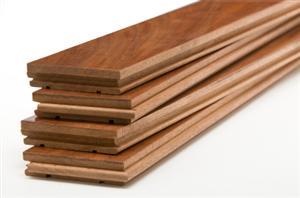| Complexity level: | 7 |
| Project cost ($): | 80 |
| Time required: | 2 days to prepare, 1 hour for observation |
| Material availability: | Easily found. |
| Safety concerns: | None |
Hypothesis
Higher density materials will transmit less sound.
Overview
Sound transmission
Sound is transmitted faster through solids than through liquids and gas. This is because sound is actually kinetic energy that is being transmitted from one molecule to another. This transfer of kinetic energy is easier if the molecules are closer to one another like in solids or liquids than in gasses. The transmission of sound also depends on the elasticity and density of the medium.
Elasticity of materials is measured when the medium can still maintain its original form and shape when a force is applied to it and then removed. A high elastic medium like steel will be able to transmit sound faster than a low elastic medium like rubber.
Another factor affecting the transmission of sound is density. High density materials will normally have bigger and heavier molecules. Since bigger molecules have a heavier mass, they will require more kinetic energy to vibrate and transmit the sound. This will make the sound transmission slower and will also dampen the sound.
Scientific Terms
Materials
The materials required for this science fair project:
- A decibel meter for measuring noise
- A battery operated siren
- A 300mm x 300mm x 300mm plywood box with slots to slide in 250mm x 250mm boards of thickness 5mm on one side only.
- A 250mm x 250mm piece of plywood of 5mm thickness
- A 250mm x 250mm bakelite of 5mm thickness
- A 250mm x 250mm sheet of glass of 5mm thickness
- A 250mm x 250mm marble tile of 5mm thickness
- A ruler
Procedure
1. For this experiment, the independent variable is the type of medium used as sound barrier. The dependent variable is the noise level outside the box measured using a decibel meter. The constants (control variables) are the size of the plywood box, the source of the sound and the distance of the decibel meter from the box.
2. One plywood box is made in the workshop or ordered from the local carpenter. For this experiment the size of 300mm x 300mm x 300mm is proposed but other dimensions can also be used. The top cover of the box should be removable to place the source of the sound inside the box and to replace the sound barrier medium on the front side of the box as shown in figure 1 below.
3. The siren is set to ring and the noise level is measured using the decibel meter placed 500mm away from the siren. The readings are recorded in the table below.
4. The siren is set to ring again and placed inside the box with the plywood medium. The top cover of the box is closed and the decibel meter is placed 500mm from the plywood board to measure the noise. The measurement is recorded in the table.
5. Procedure 4 is repeated after replacing the plywood board with the bakelite board, glass and marble tile in turn.



Results
The higher density materials of glass and marble tile had the lowest noise level and plywood the lowest density material had the highest noise level recorded by the decibel meter.
Source of sound |
Density (kg/m3) |
Noise level (dB) of siren measured outside the box |
Noise outside box with the siren inside the box |
Plywood |
600 |
72 |
62 |
Bakelite |
1250 |
72 |
54 |
Glass |
2690 |
72 |
42 |
Marble tile |
2560 |
72 |
44 |
The graph below represents the results of our science project experiment.

Conclusion
The hypothesis that the higher density material will transmit less sound is proven to be true. Higher density materials are very good sound barriers.
Sound barriers are used to protect homes that are built close to the airports, highway and train lines from noise pollution. It helps to improve the quality of life for the people who have been affected by these noise pollutions.
Also consider
The experiment can also be done comparing different elastic material like rubber, metal, etc.
Try and repeat the experiment with different source of sound like a portable CD player.
References
Noise barrier - http://en.wikipedia.org/wiki/Noise_barrier
The speed of sound in other materials - http://www.ndt-ed.org/EducationResources/HighSchool/Sound/speedinmaterials.htm

